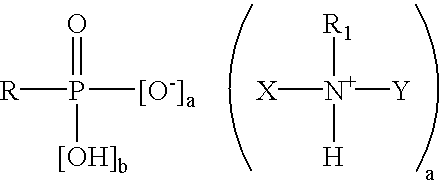Phosphonic acid derivative treatment of metallic flakes
a technology of phosphonic acid and metallic flakes, which is applied in the field of metal pigment particle treatment, can solve the problems of reducing the bright, sparkling effect of metallic flakes, limiting their utility, and reaction is a safety hazard, so as to reduce the generation of hydrogen gas, reduce the risk of flake deterioration, and protect the effect of high desirable protection
- Summary
- Abstract
- Description
- Claims
- Application Information
AI Technical Summary
Benefits of technology
Problems solved by technology
Method used
Image
Examples
example 1
Tufflake® 3645, an aluminum pigment paste available from Silberline Manufacturing Co., Inc. having average particle size of 15.9 microns and a maximum of 0.01% by weight retained on a 325 mesh sieve, is charged into a mixer. Octyl (C8) phosphonic acid is added in the amount of 2.71% of the weight of aluminum metal. The materials are mixed for one hour.
example 2
Tufflake® 4700, an aluminum pigment paste available from Silberline Manufacturing Co., Inc. having an average particle size of 13.3 microns and a maximum of 0.10% by weight retained on a 325 mesh sieve, is charged into a mixer. Octadecyl (C18) phosphonic acid is added in the amount of 0.59% of the weight of aluminum metal, and the materials are mixed for one hour.
example 3
The Tufflake® 4700 paste of Example 2 is charged into a mixer. Octyl (C8) phosphonic acid is added in the amount of 0.62% of the weight of aluminum metal, and the materials are mixed for one hour.
PUM
| Property | Measurement | Unit |
|---|---|---|
| particle size | aaaaa | aaaaa |
| particle size | aaaaa | aaaaa |
| temperature | aaaaa | aaaaa |
Abstract
Description
Claims
Application Information
 Login to View More
Login to View More - R&D
- Intellectual Property
- Life Sciences
- Materials
- Tech Scout
- Unparalleled Data Quality
- Higher Quality Content
- 60% Fewer Hallucinations
Browse by: Latest US Patents, China's latest patents, Technical Efficacy Thesaurus, Application Domain, Technology Topic, Popular Technical Reports.
© 2025 PatSnap. All rights reserved.Legal|Privacy policy|Modern Slavery Act Transparency Statement|Sitemap|About US| Contact US: help@patsnap.com



